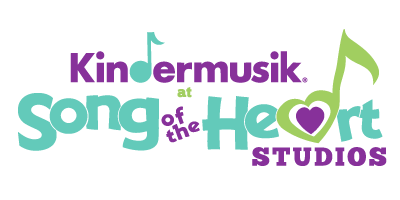It never fails. The more I learn about educational theory, the more amazed I am by the Kindermusik approach to early childhood education.
As I’m getting ready to return to a school classroom to teach Spanish (my job before being a mom and Kindermusik educator), I attended a conference for teachers of world languages last week in Denver. One of the big trends in foreign language education is Comprehensible Input, or the idea that we acquire and are able to use a new language when we understand what we hear. Of course, we have to grow, so we learn new, small chunks at a time, with lots of repetition of those chunks—it’s what Dr. Stephen Krashen calls a “plus one” component. We stick with what we can understand, and push ourselves a little bit. Over time, this brings fluency.
Kindermusik understands that a parent or guardian is the child’s best teacher, and Kindermusik educators are here to facilitate that interaction and learning. Instinctively, these caregivers are a child’s best language teacher. We simplify our vocabulary when referring to “mama,” “daddy” or “juice,” and we go from, “Juice?” to “More juice?” to “Want more juice?” in such a natural way that language educators look to them for guidance in teaching a second language.
You’ll see this mirrored in Kindermuik class, and not just in the Signing Time where kids are learning yet another new language. Specific words get repeated in songs and chants (rhythm makes everything better), and we repeat things from week to week, with little tweaks to the activity that make it grow from, for example, a seated game to a full dance.
In a Kindermusik class, our educators will model how to scaffold music-making with your child. We base this principal Vygotsky’s theories of child development. As Lynne Cameron notes in Teaching Languages to Young Learners, “(Other people) play important roles in helping children to learn, bringing objects and ideas to their attention, talking while playing and about playing, reading stories, asking questions. In a whole range of ways, adults mediate the world for children and make it accessible to them. . . . With the help of adults, children can do and understand much more than they can on their own.” (pg. 5)
In Kindermusik class, you’ll see this when you watch an adult and child tap rhythm sticks together. You’ll notice that it works best when a caregiver keeps his or her sticks still and allows the child to tap those. You’ll also see scaffolding when you watch a dance in one of the baby classes—as a little one gets twirled in the air, she gets movement through space in ways she wouldn’t be able to on her own (obviously!). Or, with the bigger kids, kids will learn the glockenspiel note by note, with lots of guidance and instruction from Ms. Carol.
In fact, this principal is so important, Vygotsky held that we measure intelligence not by what a child can or cannot do alone, but what they do with guidance. Personally, I believe the kids in our studio are extremely brilliant, but I’m probably a little biased.
Not many more weeks until Kindermusik starts back up again in the fall! Hope you’ve had a great time at a Song of the Heart Summer Camp, and we’ll see you soon. . .

